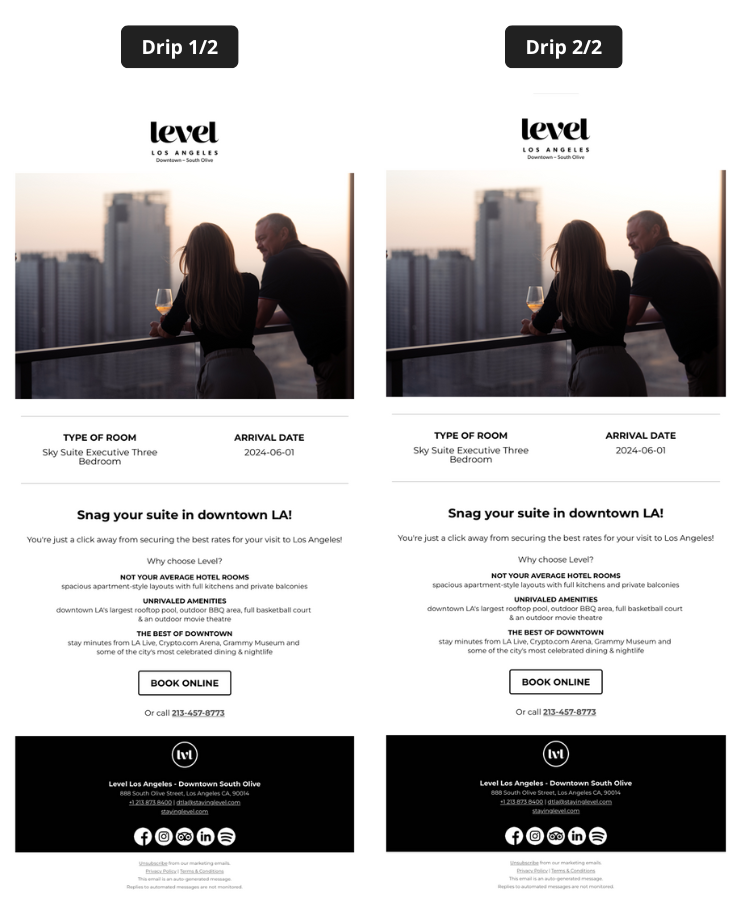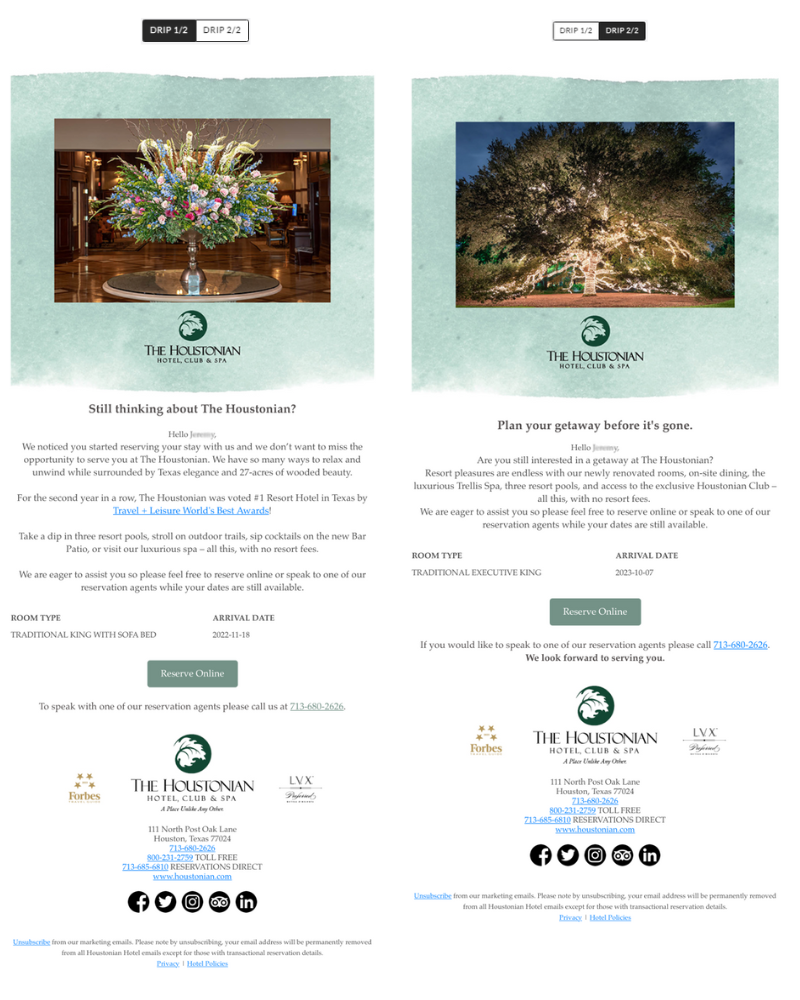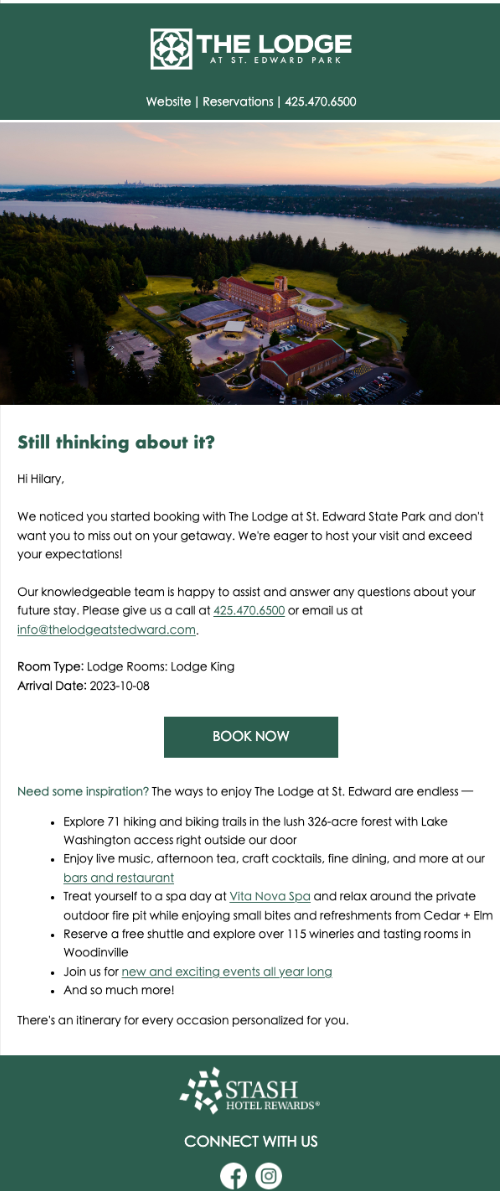Why your hotel needs an abandoned cart campaign
Why your hotel needs an abandoned cart campaign
There they go. Wave goodbye to your guests walking right out of the digital door.
Now, wait just a second. You don’t have to let that door slam in your face because prospective guests are never truly “gone.” You have the superpower to bring them right back to your booking engine and secure a stay. There’s lost revenue sitting in limbo that’s yours to claim.
With what you ask? With a well-timed, well-crafted, abandoned cart email campaign. It’s one of the most impactful tools in a hotelier’s playbook. From automated emails to personal follow-up calls, these campaigns re-engage lost guests, recover revenue, and help you convert almost booked into booked.
In this article, we’re diving into what an abandoned cart email campaign is, how it works, and why it’s a must-have for your hotel email marketing strategy. We’ll even walk you through how to build one that drives real revenue — without burning out your marketing team.
What is an abandoned cart campaign?
Cart abandonment happens in the retail setting, too. You’ve probably done it yourself — adding items to your cart from your favorite online shop, but never completing the purchase. Later, you stumble across an email in your inbox from that same retailer asking, “Did you forget something?” That’s what hoteliers experience all the time, except consumers — and in this case, guests — are abandoning the booking engine and leaving a prepped-and-ready booking in their cart.
That’s why an abandoned cart campaign is your safety net for lost bookings. When a guest picks their room, enters their details, and then ghosts you, this campaign kicks in to win them back automatically.
But have you ever wondered why guests abandon their carts in the first place? That question falls under the cart abandonment theory, which hypothesizes that guests abandoned their carts for a variety of reasons — from poor user experience and hesitancy to price to getting too distracted or just having second thoughts. Whatever the reason, a hotel booking abandonment strategy gives you a second chance to seal the deal and get them moving from the booking stage of the guest journey to prearrival.
Maybe that’s through an automatically triggered email campaign or a note to your call center to follow up on this guest with an outbound call. Whatever your preferred approach may be, having an abandonment strategy is a must for recovering these guests and lost revenue.
Are abandoned cart emails worth it?
The short answer is yes, absolutely. But, let’s look at this a little closer.
Out of 100 visitors to your hotel website, only about 2.4% of them will book. And 85% will abandon their carts instead of proceeding with their bookings. So, yes, abandoned cart emails are worth it because you’re otherwise leaving serious revenue on the table. And here’s the kicker: Abandoned cart emails have an average conversion rate of 30%, and when paired with outbound calls, conversion rates get even better.
You can see this in action. Last year, hoteliers in North America who placed outbound calls to guests who failed to book ended up driving $1,748 incremental revenue per room. And you can bet those same hoteliers captured the guests’ emails so that they could send an abandoned cart campaign. With email capture rates averaging 74% last year, hoteliers were doing abandoned cart campaigns justice.
And even better news? Abandoned cart campaigns are easy to manage. With the right setup, these campaigns practically run themselves, and they pay off in a big way.
How cart abandonment campaigns help hotels recover lost revenue
Here’s what makes abandoned cart campaigns so powerful:
- Direct revenue recovery. By re-engaging guests who showed interest but failed to book, hotels can recover a significant portion of revenue and start forming loyal guest relationships.
- Increased conversion rates. Timely and personalized follow-ups can convert abandoned carts into confirmed bookings. Planned and strategic communication is the way to go.
- Smarter guest engagement. Understanding guest behavior enables tailored communications, thereby enhancing guest satisfaction and loyalty.
Even better? Combining email with outbound calls not only adds the personal touch that hospitality is all about but also turns lookers into bookers.
This all sounds great, right? But you may find yourself asking one question: Are abandoned cart emails legal?
Yes, they’re legal — as long as you play by the rules. That means only emailing guests who’ve opted in and including an easy way to unsubscribe. If you’re following standard email marketing strategy best practices, you’re in the clear.
How to build a high-converting abandoned cart email campaign
Ready to stop losing revenue? Here’s how to set up a winning campaign:
Step 1: Define the abandonment trigger
Clearly identify what constitutes an abandoned cart. For hotels, this might be when a guest adds dates and room types to their cart but leaves the site without completing the booking. With this trigger, you can ensure that follow-up actions are timely and relevant. You don’t want a bunch of “false positives” — labeling guests “abandoned” that aren’t really abandoned.
Step 2: Integrate your systems
Your reservation agents have a long list of leads, but now you need to decide which ones to pursue and then actually follow up with them. With Revinate Reservation Sales, your team can designate guests as “hot” or “cold” leads so that your marketing team knows which leads are worth following up on. And with Revinate Marketing, they can then send targeted abandoned cart campaigns to those leads.
Step 3: Establish your email sequence and timing
Develop a series of emails, or a drip email campaign, to be sent at strategic intervals after abandonment occurs. Try sending the first email within an hour, with follow-ups over the next 24 to 72 hours. Each email should have a clear call-to-action and provide value to your guest, such as offering assistance in booking or highlighting the benefits of booking directly.
Step 4: Write compelling, segmented content
Tailor your email content to the specific interests and behaviors of the guest. Segment your audience based on factors like room type viewed, length of stay, or loyalty status. Using personalized content in your abandoned cart campaigns increases both engagement and conversion.
Step 5: Test your email performance and refine
Regularly analyze the performance of your emails, including open rates, click-through rates, and conversion rates. Use A/B testing to determine which subject lines, content, and timing yield the best results. Continuous refinement and campaign monitoring ensures that your campaign remains effective and aligned with guest preferences.
Abandoned cart email examples for hotels
If you need help getting started with your abandonment cart campaigns, take a look at some of these real-life examples that secured bookings and fostered guest relationships.
Level Los Angeles — South Olive
Here is a great example of reservations and marketing teams working together to reclaim abandoned guest bookings. With an automated drip campaign, potential guests received an initial email reminder when they left the booking engine, followed by an automated email two days later with a gentle reminder to complete the reservation. The follow-up email included a phone number to call in case the potential guest prefers to book over the phone. In all, 684 room nights were booked with this campaign alone!

The Houstonian Hotel, Club & Spa
Sometimes a sense of urgency does the trick. This is another automated drip campaign, but this time The Houstonian Hotel, Club & Spa highlighted the perks of being a guest at the hotel while also driving a sense of urgency to book online or speak to a reservation agent. And it worked. Open rates jumped to 75%!

Promote your amenities! Sometimes abandoned cart campaigns that shout your amenities from the rooftops are a great way to bring guests back to book. And it could be the ticket to driving more ancillary revenue once they get on property. Check out this abandoned cart campaign from Columbia Hospitality, with 170 room nights booked!

How Revinate makes abandoned cart campaigns easy for hoteliers
Abandoned cart campaigns aren’t meant to be a shot in the dark or a last-ditch effort. While it’s not ideal to have to chase your guests, with the right strategy, these campaigns work to not only reclaim those lost bookings and foster loyalty.
To get the most out of your abandoned cart campaigns, your reservations and marketing teams need to work together. And that’s where Revinate comes in — by uniquely combining the power of Revinate Marketing and Reservation Sales to create a full-funnel recovery strategy. Here’s how they work together:
- Revinate Marketing identifies when a guest begins the booking process but fails to complete it. The system automatically triggers a personalized abandoned cart email designed to bring the guest back.
- Then, Reservation Sales picks up where email leaves off. If the guest is designated as a “hot” lead based on Revinate’s smart data signal, your reservations team can follow up with an outbound call — adding a human touch that increases conversion likelihood.
This dual-channel approach to abandoned cart campaigns is what smart retargeting is all about. Here are a few other features that help drive revenue for your property:
- Drag-and-drop email builder tailored for hotel email marketing campaigns.
- Automated journey workflows with built-in hotel-centric triggers.
- Hot and cold guest lead scoring to determine a lead’s immediate conversion potential.
- Unified reporting to measure the ROI of your abandoned cart campaigns.
- Easy integration for a complete view of each guest.
Ready to recover more bookings and boost direct revenue?
Get our guide on cart abandonment recovery and learn how top hotels are turning missed bookings into major wins.
Related Posts
This site is protected by reCAPTCHA and the Google Privacy Policy and Terms of Service apply. View our Terms & Conditions here. *Required fields.



